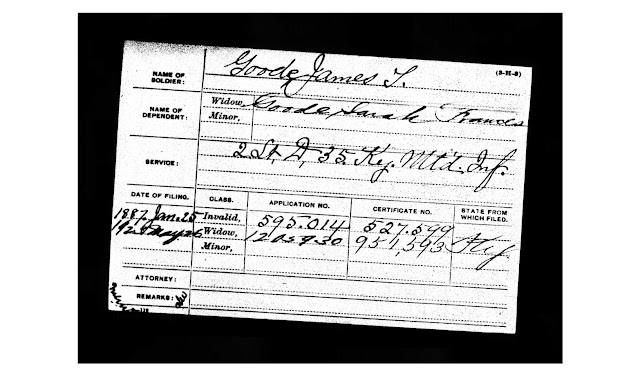Civil War Service Leads to Familial Bond
George Washington Moseley: 1843-1907. Second
Great-Granduncle
James Thornton Goode: 1845-1923. Husband of Second
Great-Grandaunt.
While researching the Robert C Moseley Family Cemetery in
McLean County, Kentucky, I ran across a photo of a monument honoring a Civil
War infantry unit. I scanned the list of soldiers, and spotted two familiar
names in the second line: the unit’s two lieutenants were Moseley family
members, brothers-in-law George Washington Moseley and James Thornton Goode,
the husband of George’s sister Sarah Frances “Fannie” Moseley Goode. As
Kentuckians, these two men could have fought on either side of the Civil
War—Kentucky never seceded but sent plenty of residents to fight for the
Confederacy. However, these two men chose to fight for the Union. I needed to
learn more about their service.
 |
| Monument honoring 35th KY Regiment |
George Moseley was born March 23, 1843 to parents Robert
Cartwright Moseley and Nancy Archibald Moseley. He was the third of their nine
children, and the eldest of their two sons. Robert and Nancy were my husband’s
third-great-grandparents. George was brother to Susan Elizabeth Moseley, Bruce’s
second-great-grandmother.
At age 20, George enlisted in the 35th Regiment
Kentucky Infantry. According to Family Search’s wiki about the regiment,
“The 35th Kentucky
Mounted Infantry was organized on the 26th day of September, 1863, at
Owensboro, Kentucky, under Colonel E.A. Starling and mustered into the United
States service on the 2nd day of October 1863. This Regiment was recruited
under the most difficult circumstances; the State, at that time, being overrun
with guerrillas, making it exceedingly hazardous for officers to recruit and
retain their men in camp. It mustered out on December 29th, 1864 at Louisville,
Kentucky.[1
The difficult task Starling faced in recruitment probably
explains why two very young and inexperienced men, George at age 20, and his
friend James Thornton Goode, only 18 years old, were given officer positions.
George served as Col. Starling’s First Lieutenant, and Thornton was the Second
Lieutenant. I wonder how the men serving under these two green officers felt
about them. Did they resent having to follow their orders, or were they just relieved
that someone other than themselves was tasked with a difficult job that put
them in the crosshairs of the Confederate guerrillas?
 |
| Colonel E. A. Starling and two soldiers--could they be George and James Thornton? |
I found this photo of Col. Starling online, with two “unidentified
soldiers”. I wonder if those two obviously young men weren’t Starling’s two lieutenants?
Having no photographs of George or Thornton in their younger years to compare
to this photo, it is impossible to prove one way or the other.
The 35th Regiment was a mounted unit, although
not officially designated as mounted infantry. I was unsure of how mounted
infantry differed from cavalry, but my research showed that cavalry units
fought while on their horses, while mounted infantry used horses to move from
one location to another rapidly, but they fought on foot. That was apparently
how the 35th Kentucky operated. Certainly moving by horse rather
than on foot would have been necessary when fighting guerilla attacks—the unit
would have needed to move very quickly.
Although George and Thornton served only a little over a
year in the Union army, they saw a decent amount of action. According to the
unit’s records on Wikipedia, the unit spent much of its time in central and eastern
Kentucky repelling Confederate guerilla fighters from the area between the
Cumberland and Green Rivers. In the fall of 1864, the unit was sent to Virginia
as part of General Burbridge’s Expedition, and they fought in the battle of
Saltville. They were sent back to Louisville in November 1864 and were mustered
out in December. The unit lost eight men in battle, and an additional 49 men to
disease.
Interestingly, both George and Thornton were still single
men when they enlisted and served. After being discharged at the end of 1864,
perhaps both men were suddenly aware of their mortality, and were ready to move
forward and establish families. Perhaps they wanted to choose life and a future
over the death and destruction they witnessed at war. Whatever their
motivation, just months after returning home, both men chose to marry. George,
being the elder at 22, picked a bride first. He married Mary Ellen Hancock on
May 22, 1865. Mary was only sixteen, while George was 22. Interestingly, Mary
Ellen’s brother John C. Hancock married George’s sister Ara Lavina just a few years later. Tragically, she died at only age 22.
Thornton took a few more months to court George’s younger sister
Fannie. They married less than a year after his return on October 19, 1865.
Fannie was only sixteen. Thornton was barely twenty.
 |
| George in old age |
George and Thornton chose to remain in McLean County,
Kentucky. They both farmed and raised families. George and Mary Ellen had at
least eight children, while Thornton and Fannie had a dozen children! Both men
received pensions as Civil War Veterans.
 |
| Civil War Pension card for James Thornton Goode |
George died August 4, 1907 at age 64. He had been ill for several weeks, long enough for several of his surviving children to reach his bedside.
Thornton
died May 3, 1923 at age 78. According to his obituary, he had been legally
blind for over fifty years! Someone found a poem in his family Bible that he
supposedly wrote, which I include below (if he truly were blind, how did he
write a poem?).
These two men began as brothers-in-arms and friends,
accepting great responsibility at a very young age and serving their country
with honor. They became brothers-in-law, their wartime bond becoming permanent.
Sources:
https://www.familysearch.org/en/wiki/35th_Regiment,_Kentucky_Infantry_(Union)
http://sites.rootsweb.com/~kymercer/CivilWar/Union/35inf/35inf-3.html







No comments:
Post a Comment